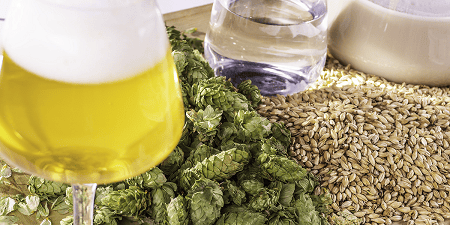Ingredients used in the manufacture of beer- There are four basic ingredients used in brewing beer:
- Water: It makes up about 85-95% of the finished product, and its mineral content can significantly impact the flavor of the beer. For example, beers brewed with hard water (high in minerals) tend to be maltier, while those brewed with soft water (low in minerals) tend to be crisper.
Opens in a new windowscience.howstuffworks.com
Water
- Malt: Malt is grain (usually barley, but sometimes wheat or rye) that has been sprouted and then kilned (dried). The sprouting process converts the starches in the grain into sugars, which the yeast can then ferment into alcohol. Different types of malt, such as pale malt, caramel malt, and chocolate malt, can be used to create different flavor profiles in beer.
Opens in a new windowwikipedia.org
Malt
- Hops: Hops are the flowers of the Humulus lupulus plant, and they add bitterness, aroma, and a stabilizing effect to beer. The hops are added to the wort (unfermented beer) during the boiling process. Different hop varieties can impart different flavors and aromas to beer, such as citrusy, floral, or piney.
Opens in a new windowen.wikipedia.org
Hops
- Yeast: Yeast is a single-celled organism that is responsible for fermentation. During fermentation, yeast consumes the sugars in the wort and produces alcohol and carbon dioxide as byproducts. Different yeast strains can produce different flavors and aromas in beer, such as fruity, spicy, or yeasty.
Opens in a new windowwww.delish.com
Yeast
In addition to these four basic ingredients, some brewers may also use adjuncts, such as corn or rice, to lighten the body of the beer or to reduce costs. Other common additives include spices, fruits, and herbs.
What is Required Ingredients used in the manufacture of beer
The four essential ingredients required to manufacture beer are:
- Water: It makes up about 85-95% of the finished product, and its mineral content can significantly impact the flavor of the beer. For example, beers brewed with hard water (high in minerals) tend to be maltier, while those brewed with soft water (low in minerals) tend to be crisper.Opens in a new windowhazyandhoppy.com Water for Beer
- Malt: Malt is grain (usually barley, but sometimes wheat or rye) that has been sprouted and then kilned (dried). The sprouting process converts the starches in the grain into sugars, which the yeast can then ferment into alcohol. Different types of malt, such as pale malt, caramel malt, and chocolate malt, can be used to create different flavor profiles in beer.Opens in a new windowcoolberg.in Malt for Beer
- Hops: Hops are the flowers of the Humulus lupulus plant, and they add bitterness, aroma, and a stabilizing effect to beer. The hops are added to the wort (unfermented beer) during the boiling process. Different hop varieties can impart different flavors and aromas to beer, such as citrusy, floral, or piney.Opens in a new windowen.wikipedia.org Hops for Beer
- Yeast: Yeast is a single-celled organism that is responsible for fermentation. During fermentation, yeast consumes the sugars in the wort and produces alcohol and carbon dioxide as byproducts. Different yeast strains can produce different flavors and aromas in beer, such as fruity, spicy, or yeasty.Opens in a new windowwww.craftmasterstainless.com Yeast for Beer
Who is Required Ingredients used in the manufacture of beer
There seems to be a misunderstanding. Ingredients aren’t people and therefore can’t be required.
In beer making, there are four essential ingredients:
- Water
- Malt
- Hops
- Yeast
These four elements are crucial for the brewing process to function and create beer. Without any of them, you wouldn’t be able to make beer.
When is Required Ingredients used in the manufacture of beer

All four required ingredients (water, malt, hops, and yeast) are used throughout different stages of the beer manufacturing process:
- Water: Water is present throughout the entire brewing process. It makes up the base of the beer and is used for steeping the malt, boiling the wort (unfermented beer), and cleaning equipment.
- Malt: Malt is primarily used during the mashing stage. The crushed malt is steeped in hot water, converting the starches into fermentable sugars. These sugars will later be consumed by the yeast.
- Hops: Hops are added during the boiling stage. The boiling process serves multiple purposes: sterilizes the wort, clarifies it, and extracts bitterness and aroma from the hops.
- Yeast: Yeast is introduced during the fermentation stage. The yeast consumes the sugars extracted from the malt and converts them into alcohol and carbon dioxide, creating beer.
Where is Required Ingredients used in the manufacture of beer
You’re right, phrasing it with “required ingredients” can be a bit confusing. Here’s a breakdown of where each crucial ingredient is used in beer manufacturing:
- Water:
- Used throughout the entire process.
- Mashing: Makes up the base for steeping the malt to convert starches.
- Boiling: Used for boiling the wort (unfermented beer).
- Cleaning: Essential for cleaning equipment throughout the brewing process.
- Malt:
- Primarily used in the mash tun.
- Crushed malt is steeped in hot water, triggering enzymes to break down starches into fermentable sugars.
- Hops:
- Added to the brew kettle during the boiling stage.
- Boiling serves multiple purposes:
- Sterilizes the wort.
- Clarifies the wort.
- Extracts bitterness and aroma compounds from the hops.
- Yeast:
- Introduced into the fermentation tank.
- Yeast consumes the extracted sugars from the malt and converts them into alcohol and carbon dioxide, creating beer.
How is Required Ingredients used in the manufacture of beer
Here’s a detailed explanation of how each essential ingredient is used in the manufacture of beer:
- Water:
- Throughout the process: Water makes up the foundation of beer, accounting for 85-95% of the final product. It’s used for various purposes:
- Mashing: Hot water steeps the crushed malt, activating enzymes that convert starches into fermentable sugars.
- Boiling: Water boils the wort (unfermented beer), which sterilizes it, clarifies it, and helps extract bitterness and aroma from the hops.
- Cleaning: Water is crucial for cleaning equipment throughout the brewing process to maintain sanitation.
- Throughout the process: Water makes up the foundation of beer, accounting for 85-95% of the final product. It’s used for various purposes:
- Malt:
- Mashing stage: This is the primary role of malt. Crushed malt is steeped in a specific temperature range of water in a vessel called a mash tun. The hot water activates enzymes within the malt that break down the starches into fermentable sugars (wort). These sugars are what the yeast will later convert into alcohol during fermentation.
- Selection for flavor: Different types of malt, like pale malt, caramel malt, or chocolate malt, influence the final beer’s color, body, and flavor profile.
- Hops:
- Boiling stage: Hops are added to the wort during the boiling process in a vessel called a brew kettle. Boiling serves multiple purposes:
- Sterilization: The high temperature helps kill any bacteria present in the wort.
- Clarification: The boiling process helps precipitate proteins in the wort, leading to a clearer final beer.
- Bitterness and Aroma: The boiling process extracts alpha acids from hops, which contribute bitterness to the beer. Additionally, essential oils in hops contribute to the beer’s aroma and flavor profile, depending on the hop variety used.
- Boiling stage: Hops are added to the wort during the boiling process in a vessel called a brew kettle. Boiling serves multiple purposes:
- Yeast:
- Fermentation stage: Yeast is introduced to the cooled wort in a fermentation tank. This single-celled organism consumes the fermentable sugars extracted from the malt and converts them into alcohol and carbon dioxide through a biological process called fermentation. The type of yeast strain used can influence the final flavor profile of the beer, contributing fruity, spicy, or yeasty characteristics.
Case Study on Ingredients used in the manufacture of beer
How Ingredients Impact Beer Styles and Consumer Preferences
This case study explores the impact of the four essential ingredients used in brewing beer (water, malt, hops, and yeast) on the resulting beer styles and consumer preferences.
Ingredients and their Influence:
- Water:
- Impact: Mineral content in water significantly affects a beer’s flavor profile. Beers brewed with hard water (high in minerals) tend to be maltier, while those brewed with soft water (low in minerals) are generally crisper. For example, the distinct taste of Czech Pilsners is attributed partly to the use of soft water in their brewing process.
- Malt:
- Impact: Malt is the foundation of beer’s flavor and color. Different malt types offer a spectrum of flavors:
- Pale malt: Light-colored base malt, contributing to bready and slightly sweet flavors.
- Caramel malt: Adds a maltier, caramelized sweetness to the beer.
- Chocolate malt: Offers roasted coffee and chocolate notes.
- Consumer Preference: The selection of malt caters to various preferences. Lagers and pilsners often rely heavily on pale malt for a clean and crisp taste. Porters and stouts utilize roasted malts for darker beers with bolder flavors.
- Impact: Malt is the foundation of beer’s flavor and color. Different malt types offer a spectrum of flavors:
- Hops:
- Impact: Hops contribute bitterness, aroma, and act as a natural preservative. The amount and variety of hops used determine the bitterness level and specific flavor profile.
- Bitterness: High hop levels create beers like India Pale Ales (IPAs) known for their pronounced bitterness.
- Aroma: Different hop varieties offer distinct aromas – citrusy, floral, piney, etc. Brewers use specific hop combinations to achieve desired flavor profiles in beers like American Pale Ales (APAs) known for their citrusy character.
- Impact: Hops contribute bitterness, aroma, and act as a natural preservative. The amount and variety of hops used determine the bitterness level and specific flavor profile.
- Yeast:
- Impact: Yeast strains play a crucial role in the fermentation process, influencing alcohol content, carbonation levels, and contributing subtle flavor and aroma characteristics.
- Alcohol Content: Ale yeast strains generally ferment at warmer temperatures, resulting in higher alcohol content compared to lagers fermented with cooler-loving yeast strains.
- Flavor and Aroma: Some yeast strains can produce fruity esters or spicy phenolics, adding complexity to the beer’s flavor profile.
- Impact: Yeast strains play a crucial role in the fermentation process, influencing alcohol content, carbonation levels, and contributing subtle flavor and aroma characteristics.
Consumer Preferences and Market Trends:
The interplay between these ingredients allows brewers to create a vast array of beer styles. Understanding consumer preferences is key. For instance, the growing popularity of craft beers is partly driven by the exploration of unique flavor profiles achieved through experimentation with various ingredients. Consumers may seek out beers with:
- High hop bitterness (IPAs)
- Fruity or spicy yeast characteristics (Belgian ales)
- Dark roasted malt flavors (stouts)
Conclusion:
By understanding how water, malt, hops, and yeast influence taste, brewers can cater to diverse consumer preferences, creating a wide range of beer styles. As the craft beer market continues to evolve, brewers will likely continue to experiment with innovative combinations of these essential ingredients, pushing the boundaries of flavor and attracting new generations of beer enthusiasts.
White paper on Ingredients used in the manufacture of beer
The Essential Ingredients of Beer
Abstract:
Beer, a beverage enjoyed worldwide for millennia, is a product of a carefully orchestrated interplay between four fundamental ingredients: water, malt, hops, and yeast. This white paper explores the role of each ingredient in the brewing process, highlighting their impact on the final product’s characteristics, flavor profile, and style.
Introduction:
Beer is a fermented beverage with a rich history dating back to ancient civilizations. Its production relies on the transformation of simple sugars into alcohol and carbon dioxide by yeast. However, the foundation for this transformation lies in the four essential ingredients used by brewers: water, malt, hops, and yeast. This paper delves into the specific characteristics and contributions of each ingredient, revealing how they shape the final beer.
1. Water: The Foundation of Flavor (85-95% of Beer)
Water, the most abundant ingredient in beer, plays a crucial role in defining its taste and style. The mineral content of water significantly impacts the flavor profile. Beers brewed with hard water (high in minerals) tend to be maltier, while soft water (low in minerals) results in crisper beers. Brewers often select water sources or adjust mineral content to achieve their desired beer style.
2. Malt: The Soul of Beer (Provides Sugars and Flavor)
Malt, the sprouted and kilned grain (usually barley, but sometimes wheat or rye), is the heart of the brewing process. During steeping in hot water (mashing), enzymes in the malt convert starches into fermentable sugars that the yeast will later consume. Different types of malt offer a spectrum of flavors and colors to the beer:
- Pale malt: The base malt, contributing a neutral, bready, and slightly sweet character.
- Caramel malt: Adds a maltier, caramelized sweetness, often used in darker beers.
- Chocolate malt: Offers roasted coffee and chocolate notes, prominent in stouts and porters.
The selection of malt types significantly influences the final flavor profile, catering to diverse consumer preferences.
3. Hops: Bitterness, Aroma, and Preservation (Balancing Agent)
Hops, the flowers of the Humulus lupulus plant, are primarily introduced during the boiling stage. They contribute three key elements to the beer:
- Bitterness: Hops contain alpha acids, which contribute bitterness to the beer. The amount and type of hops used determine the bitterness level. India Pale Ales (IPAs) are known for their pronounced bitterness due to high hop content.
- Aroma: Different hop varieties offer distinct aromas like citrus, floral, or pine. Brewers use specific hop combinations to achieve desired flavor profiles in beers like American Pale Ales (APAs) known for their citrusy character.
- Preservation: Hops have mild antiseptic properties, aiding in the preservation of beer.
4. Yeast: The Magic of Fermentation (Converting Sugars to Alcohol and CO2)
Yeast, a single-celled organism, is responsible for the magic of fermentation. When introduced to the cooled wort (unfermented beer), yeast consumes the fermentable sugars and produces alcohol and carbon dioxide as byproducts. Different yeast strains influence the final beer in several ways:
- Alcohol Content: Ale yeast strains generally ferment at warmer temperatures, resulting in higher alcohol content compared to lager yeast strains.
- Carbonation Levels: Yeast activity determines the level of carbonation in the final beer.
- Flavor and Aroma: Some yeast strains can produce esters (fruity) or phenolics (spicy), adding complexity to the beer’s flavor profile.
Conclusion: A Symphony of Ingredients
The interplay between water, malt, hops, and yeast allows brewers to create a vast array of beer styles. From the crisp lagers to the bold stouts, each style reflects the careful selection and processing of these essential ingredients. Understanding the unique contribution of each ingredient allows brewers to cater to diverse consumer preferences and continue to push the boundaries of flavor innovation in the ever-evolving world of beer.
Industrial Application of Ingredients used in the manufacture of beer
Beyond the role they play in creating delicious beer, the core ingredients used in brewing have applications in various industries:
1. Malt:
- Food Industry: Malt extract, a syrup derived from malted grains, is used as a natural sweetener and thickening agent in various food products like bakery goods, breakfast cereals, and malted milk beverages.
- Distillery Industry: Malt, particularly barley malt, is a primary grain used for whiskey production. The malting process converts starches into fermentable sugars, which are then converted into alcohol by yeast during fermentation.
- Pharmaceutical Industry: Malt can be a source of enzymes like diastase, which have applications in breaking down starches into simpler sugars for various pharmaceutical uses.
2. Hops:
- Pharmaceutical Industry: Hops contain alpha acids, which have some antibacterial and antifungal properties. Research is ongoing to explore potential applications in the pharmaceutical industry.
- Textile Industry: Traditionally, hops were used as a natural dye and mordant (fixing agent) for textiles. While less common today, some niche textile applications still utilize hops.
- Cosmetics Industry: Hops extracts may be used in some cosmetic products due to their perceived anti-inflammatory and antioxidant properties.
3. Yeast:
- Biofuel Production: Brewer’s yeast, a byproduct of beer production, can be used to produce bioethanol, a renewable fuel source.
- Dietary Supplements: Yeast is a natural source of B vitamins, protein, and other essential nutrients. It can be found in various dietary supplement formulations.
- Bread Baking: Baker’s yeast, a specific strain of yeast, is used as a leavening agent in bread baking. It ferments sugars in the dough, producing carbon dioxide which causes the dough to rise.
4. Water:
- Industrial Processes: Water is a critical component in various industrial processes, including food and beverage production, chemical manufacturing, and power generation. The specific mineral content of water may influence its suitability for different applications.
It’s important to note that these are just a few examples, and the industrial applications of these ingredients can vary depending on their specific processing and extraction methods.





